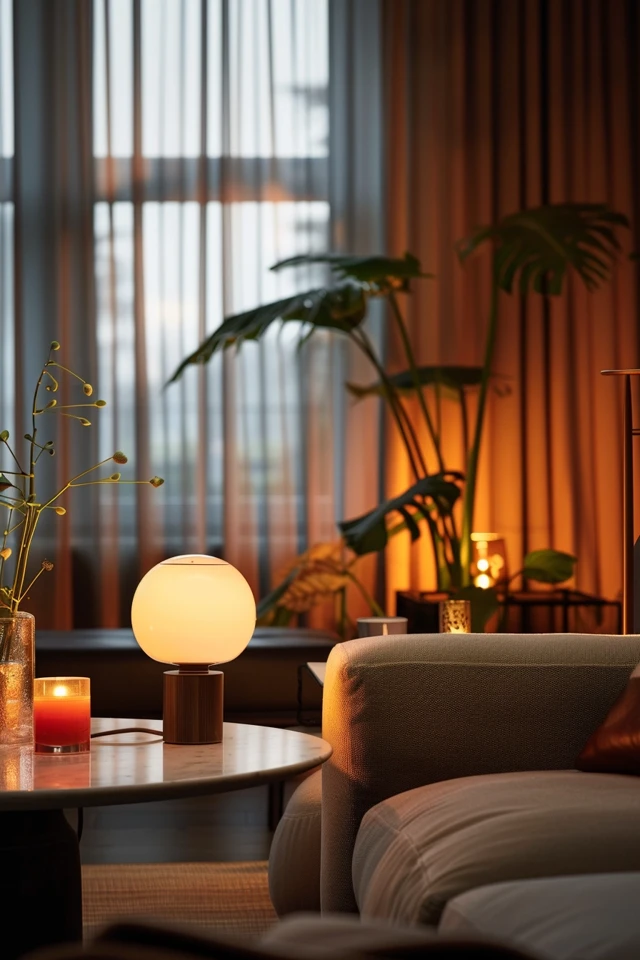If you’re searching for ideas on how to light a living room with no overhead lighting, I have some bright ideas to inspire you. Adding lamps and task lighting is important for functionality, while twinkle lights or art lights can create a focal point. Opening up the corners of a room with lighting creates depth and coziness.
When choosing lighting for your living room, consider the color temperature and brightness of the bulbs, as well as how the shade diffuses light for a softer glow. Additionally, floor lamps, plug-in chandeliers, arc lamps, uplights, table lamps, and plug-in sconces are all great options for illuminating a room without overhead lighting. Utilize these lighting techniques to create a well-lit and inviting space.
Key Takeaways:
- Adding lamps and task lighting is important for functionality
- Twinkle lights or art lights can create a focal point
- Opening up the corners of a room with lighting creates depth and coziness
- Consider the color temperature and brightness of bulbs when choosing lighting
- Utilize floor lamps, plug-in chandeliers, arc lamps, uplights, table lamps, and plug-in sconces to illuminate a room without overhead lighting
Alternative Lighting Ideas for Rooms Without Overhead Lighting
When faced with a room that lacks overhead lighting, I understand the need for alternative lighting ideas. Let me share with you some creative options that can effectively illuminate your space.
- Floor Lamps: Floor lamps are versatile and can provide both ambient and task lighting. Their tall design makes them perfect for placing in corners or tight spaces, ensuring your room is well-lit.
- Plug-in Chandeliers: If you’re looking to add elegance to your room, consider using plug-in chandeliers. These stunning fixtures can be hung from a ceiling hook, instantly transforming your space with a touch of sophistication.
- Arc Lamps: For a modern and stylish lighting solution, arc lamps are a great choice. You can easily direct the light where you need it most, making them ideal for reading corners or desk areas.
- Uplights: Adding uplights is an excellent way to highlight special features in a room. These lights can be placed behind mirrors or plants, creating a beautiful and dramatic effect.
- Table Lamps: Table lamps offer both functionality and style. You can place them on end tables, desks, or bookshelves, providing the perfect amount of light for different activities in the room.
- Plug-in Sconces: If convenience and style are what you’re after, consider using plug-in sconces. These fixtures provide both task lighting and a decorative element, enhancing the overall ambiance of your space.

By incorporating these alternative lighting ideas, you can effectively illuminate your room without relying on overhead fixtures. The key is to choose lighting options that meet your specific needs and enhance the overall aesthetics of the space.
Remember, lighting is not just about practicality; it also plays a crucial role in setting the ambiance of a room. Experiment with different lighting combinations to achieve the desired effect. Whether you’re creating a cozy reading nook or a vibrant entertaining space, these alternative lighting ideas will help you achieve the perfect lighting solution for your room.
Tips for Creating a Well-Lit Space Without Overhead Lighting
When it comes to lighting a room without overhead fixtures, strategic planning and creativity are key. By considering different lighting techniques and implementing unique alternatives, you can easily create a well-lit and inviting space. Here are some tips to help you illuminate your room without ceiling lights:
Determine the Functionality and Lighting Needs
Before diving into the lighting arrangement, think about how you intend to use the room. Will it serve as a cozy reading nook or a productive office space? By identifying the functionality, you can determine the appropriate lighting requirements for each area.
Divide the Room into Zones
Creating distinct zones within the room allows you to target lighting where it is needed most. Consider using a combination of floor lamps, desk lamps, and accent lighting to provide customized illumination for each zone. This not only improves functionality but also adds depth and visual interest to the room.

Layer the Lighting
Layering different types of lighting is crucial in achieving a well-balanced and versatile lighting scheme. Combine ambient lighting, such as floor lamps, with task lighting, like desk lamps, to provide a combination of overall illumination and focused light for specific activities. Additionally, incorporate accent lighting to highlight architectural features or decorative elements.
Choose the Right Light Bulbs and Shades
The choice of light bulbs and shades can significantly impact the overall lighting effect. Opt for light bulbs with the appropriate color temperature and brightness to create the desired ambiance. Consider using shades that diffuse the light to achieve a softer and more pleasant glow throughout the room.
By following these tips and exploring creative lighting alternatives, you can successfully light up a room without relying on overhead fixtures. Remember to create a well-thought-out plan, divide the room into zones, layer the lighting, and choose the right light bulbs and shades. With these techniques, you can transform any space into a well-lit and inviting environment.

Conclusion
Illuminating a room without overhead lighting may seem like a challenge, but with the right techniques and lighting alternatives, it is possible to create a well-lit and inviting space. By incorporating various lighting options like floor lamps, plug-in chandeliers, arc lamps, uplights, table lamps, and plug-in sconces, you can achieve both functionality and style.
Creating a comprehensive lighting plan that includes ambient, task, and accent lighting is essential for ensuring that the room is well-lit and meets your specific needs. Remember to take into account the color temperature and brightness of the bulbs, as well as the shade’s ability to diffuse light for a softer glow.
By following these tips and utilizing these lighting techniques, you can successfully illuminate a room without overhead lighting, transforming it into a space that is both visually pleasing and functional.

